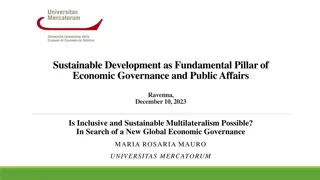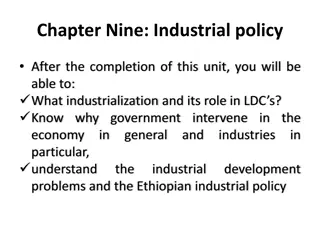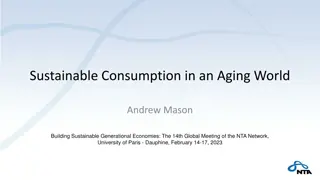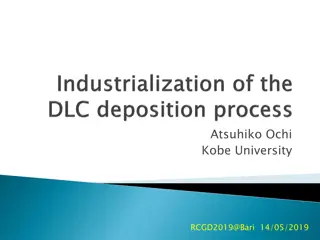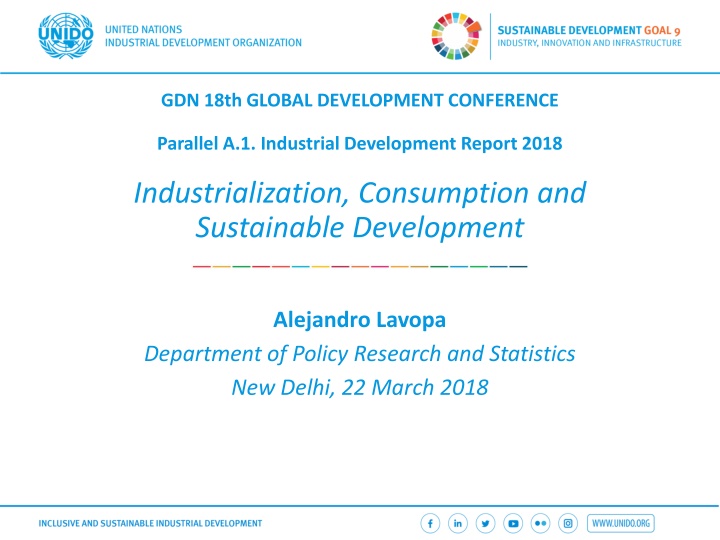
Industrialization, Consumption and Sustainable Development
Dive into the complexities of industrial development, consumption patterns, and sustainable growth presented in the Industrial Development Report 2018 by Alejandro Lavopa. Explore the challenges and opportunities in these key areas of global development, offering insights and strategies for a more sustainable future.
Download Presentation

Please find below an Image/Link to download the presentation.
The content on the website is provided AS IS for your information and personal use only. It may not be sold, licensed, or shared on other websites without obtaining consent from the author. If you encounter any issues during the download, it is possible that the publisher has removed the file from their server.
You are allowed to download the files provided on this website for personal or commercial use, subject to the condition that they are used lawfully. All files are the property of their respective owners.
The content on the website is provided AS IS for your information and personal use only. It may not be sold, licensed, or shared on other websites without obtaining consent from the author.
E N D
Presentation Transcript
GDN 18th GLOBAL DEVELOPMENT CONFERENCE Parallel A.1. Industrial Development Report 2018 Industrialization, Consumption and Sustainable Development Alejandro Lavopa Department of Policy Research and Statistics New Delhi, 22 March 2018
IDR 2018: A demand-perspective to industrial development A major novelty of this report is the shift in focus: from production to consumption What matters for consumers is the provision of new, better and more affordable goods (affordable variety) Placing the provision of affordable variety at the center changes our understanding of manufacturing s relative importance and impact: i. Relative importance: from a demand-perspective manufacturing is not shrinking over time. On the contrary: it is growing in relative terms. Effects on living standards: the provision of affordable variety increases consumer welfare and contributes to the achievement of several SDGs The main driver of these outcomes is the high innovativeness of the sector, both in terms of process and product innovations. ii. 2
The Importance of Manufacturing: Traditional supply-side view 19.8% Two most extended indicators Global decline in the share of manufacturing in Nominal GDP (4.1 p.p.) Global decline in the share of manufacturing in Total Employment (3 p.p.) Evidence of de- industrialization at the world level decreasing importance of manufacturing over time? 20% Share of Manufacturing in Nominal GDP 18% 15.6% 16% 14.5% 14% Share of Manufacturing in Total Employment 12% 11.5% 10% 1993 2010 1991 1992 1994 1995 1996 1997 1998 1999 2000 2001 2002 2003 2004 2005 2006 2007 2008 2009 2011 2012 2013 2014 Source: GDP shares: UNIDO based on Manufacturing Value Added Database (UNIDO, 2017) Employment shares: UNIDO based on ILO KILM and Trends Econometric Models 3
The Importance of Manufacturing: Driving productivity gains The previous picture, however, mask two key features of manufacturing First and foremost, manufacturing industries drive overall productivity Evidence from labour productivity dynamics Increasing gap between global productivity in manufacturing and the overall economy decreasing requirements of workers per unit of value added 40.0 Value added per worker (thousands constant 2010 USD) 35.0 32.6 Real Value Added per Worker (Manufacturing) 30.0 25.0 23.3 20.0 17.5 Real Value Added per Worker (All Economy) 17.2 15.0 10.0 1991 2000 1992 1993 1994 1995 1996 1997 1998 1999 2001 2002 2003 2004 2005 2006 2007 2008 2009 2010 2011 2012 2013 2014 Source: Value Added: UNIDO based on Manufacturing Value Added Database (UNIDO, 2017) Employment: UNIDO based on ILO KILM and Trends Econometric Models 4
The Importance of Manufacturing: and lowering (relative) prices The second feature relates to price dynamics Evidence from implicit VA deflators At an aggregate, world- level, prices of manufacturing increase at a much lower pace than the overall economy Hence, relative prices in manufacturing tend to decline manufacturing goods become relatively cheaper through time 200 1.1 Implicit gorss value added deflator (index, 1991=100) Relative price of manufacturing Relative Prices (Right axis) 170 175 1.0 Implicit Value Added Deflator (All Economy) 150 0.9 124 125 0.8 100 0.7 Implicit Value Added Deflator (Manufacturing) 75 0.6 1991 1993 1995 1997 1999 2001 2003 2005 2007 2009 2011 2013 Source: UNIDO based on Manufacturing Value Added Database (UNIDO, 2017) 5
The Importance of Manufacturing: bringing more goods at cheaper prices Instead of nominal GDP, we look at real GDP [that is, keeping constant prices of a base year] In real terms, the share is extremely stable and shows an increasing trend from the early 1990s. The level depends on the base year selected. instead of global de- industrialization, increasing affordable variety 20% 18% 16.0% 16% 14.8% 14.8% Share of Manufacturing in Real GDP (2010 prices) 14% 12% 10% 1997 1991 1992 1993 1994 1995 1996 1998 1999 2000 2001 2002 2003 2004 2005 2006 2007 2008 2009 2010 2011 2012 2013 2014 Source: UNIDO based on Manufacturing Value Added Database (UNIDO, 2017) 6
The Importance of Manufacturing: similar story for India The evidence for India shows a similar pattern Declining trend in the manufacturing nominal share . . but increasing share when prices are kept constant Also, clear decline in relative prices manufacturing increasing importance as a provider of affordable variety 20.0% 1.05 Share in GDP Relative price of manufacturing Share of Manufacturing in Nominal GDP 17.5% 0.98 16.8% 17.5% 15.9% 15.0% 0.90 Share of Manufacturing in Real GDP (2010 prices) 14.4% 12.5% 0.83 Relative Prices (Right axis) 10.0% 0.75 1993 1991 1995 1997 1999 2001 2003 2005 2007 2009 2011 2013 Source: UNIDO based on Manufacturing Value Added Database (UNIDO, 2017) 7
The role of innovation: creating new goods, improving quality and driving prices down The provision of affordable variety results from the high innovativeness of the manufacturing sector. Manufacturing is the main hub of R&D - R&D intensity tend to be much larger in manufacturing than in other sectors of the economy (OECD countries, for instance, 7 times larger on average) R&D and other search activities enable product and process innovations: - Product innovations are related to the introduction of new goods in the market or the improvement in quality of existing ones. This increases the variety of the economy. - Process innovation are related to the way in which goods are produced and lead to the improvement in production efficiency, ultimately enabling price reductions. 8
Welfare gains from affordable variety: consumers perspective Access to new goods Which also increase the range of available choices CONSUMER WELFARE of increasing quality at lowering prices 9
Welfare gains from affordable variety: development perspective Access to consumption in the bottom of the pyramid / frugal innovations Access to Access to affordable and quality food SUSTAINABLE DEVELOPMENT environmental goods Access to affordable and quality medicines 10
Three key lessons 1. The importance of manufacturing can hardly be restricted to the creation of direct jobs or to its share in nominal GDP. Manufacturing is also the prime provider of new varieties and qualities of goods. 2. Through time, manufacturing industries tend to bring prices down and make these new varieties and qualities of goods affordable for an increasing number of people. 3. The provision of affordable variety results from the high levels of innovation and technical change of the manufacturing sector, both in terms of product and process innovations. 11
Thanks for your attention! Alejandro Lavopa 12

